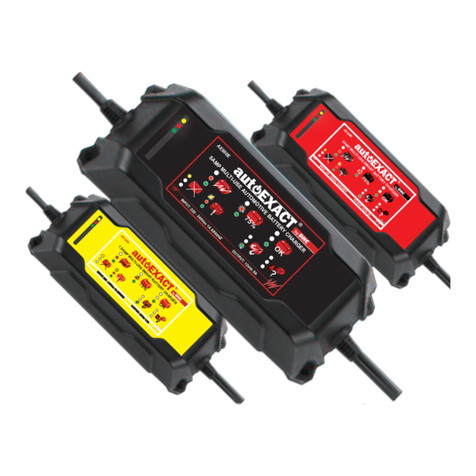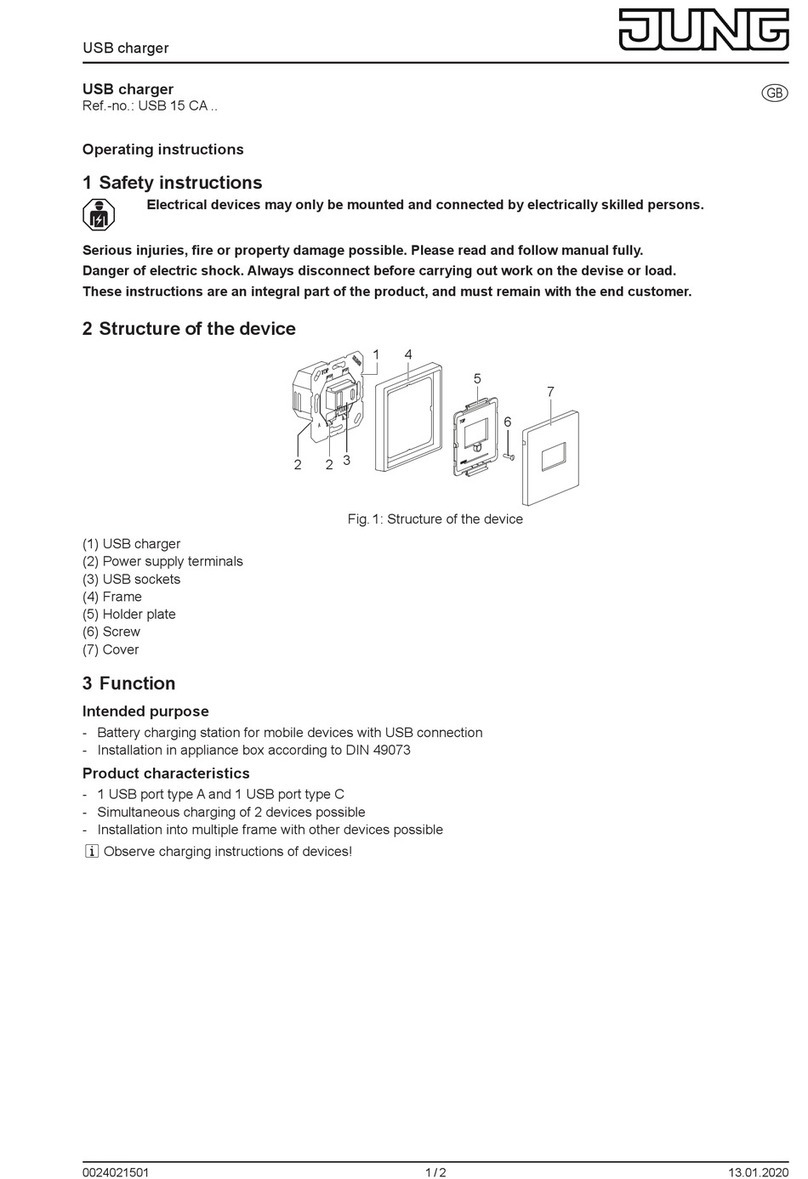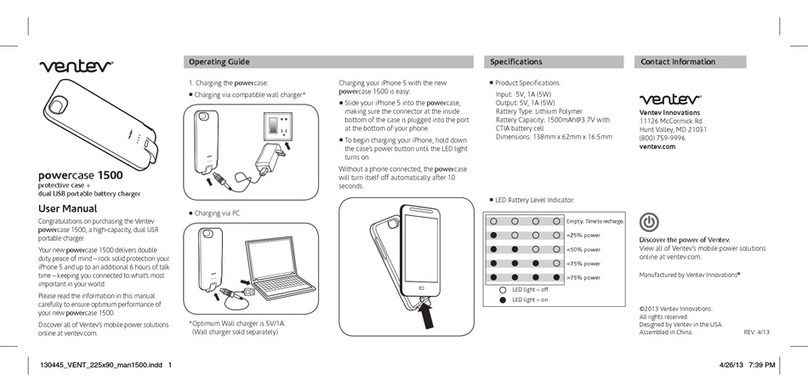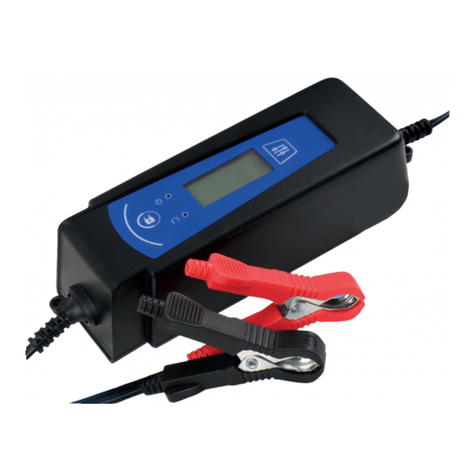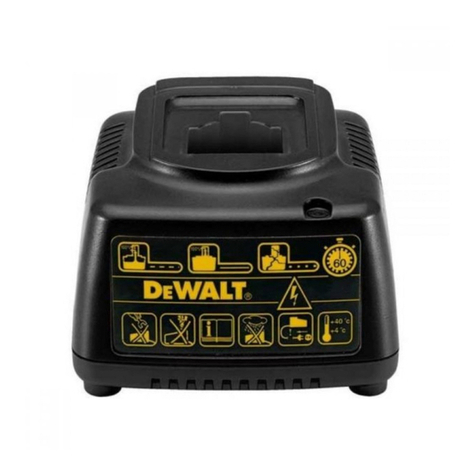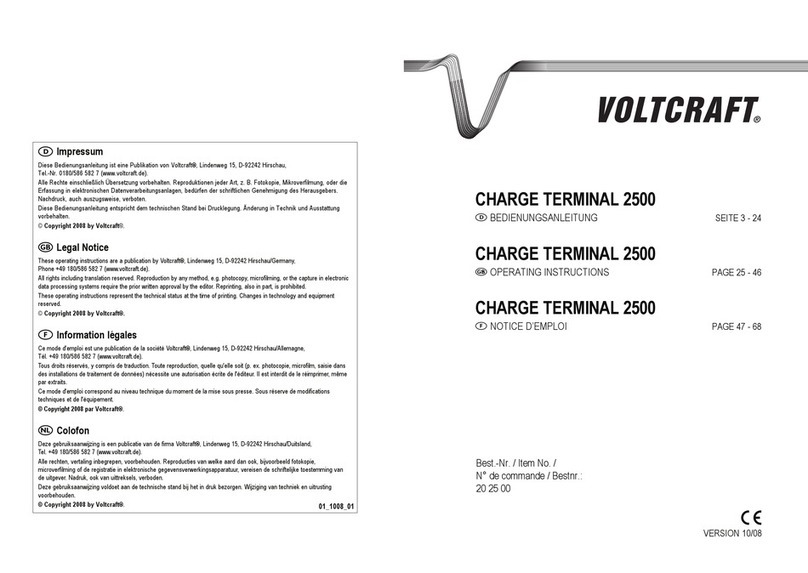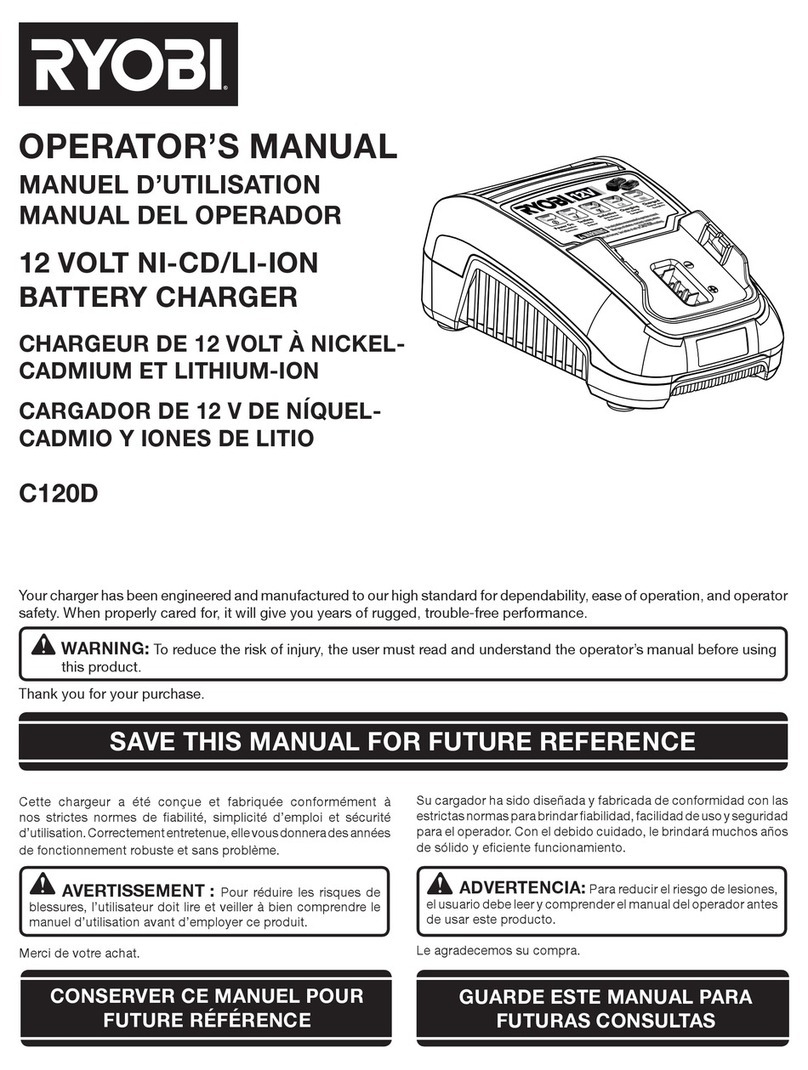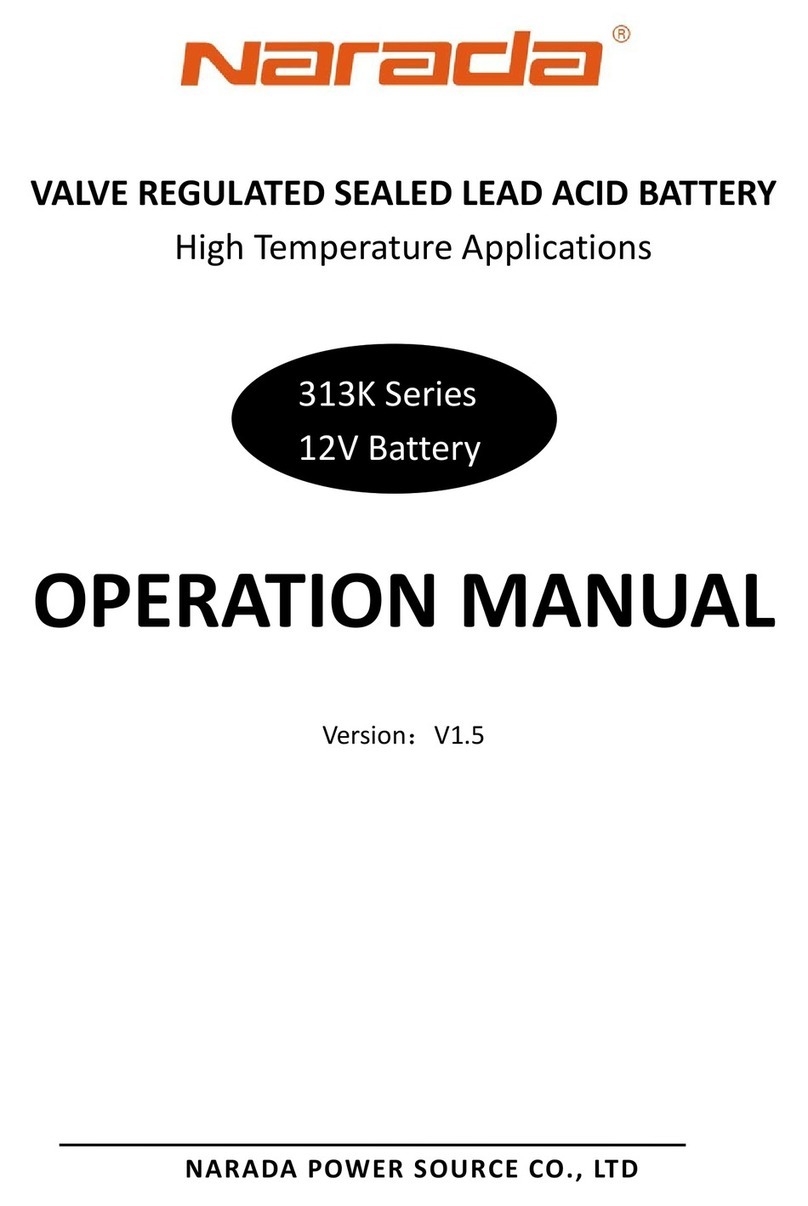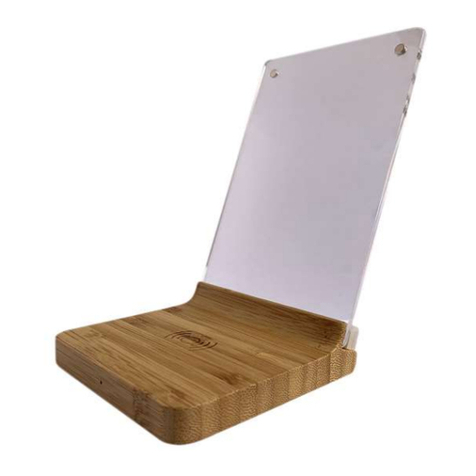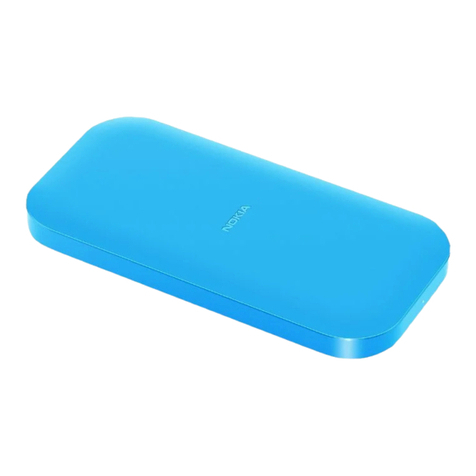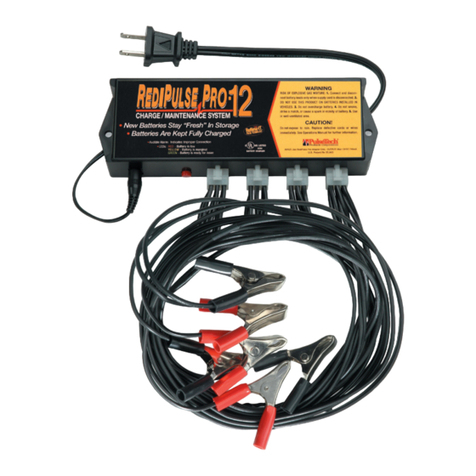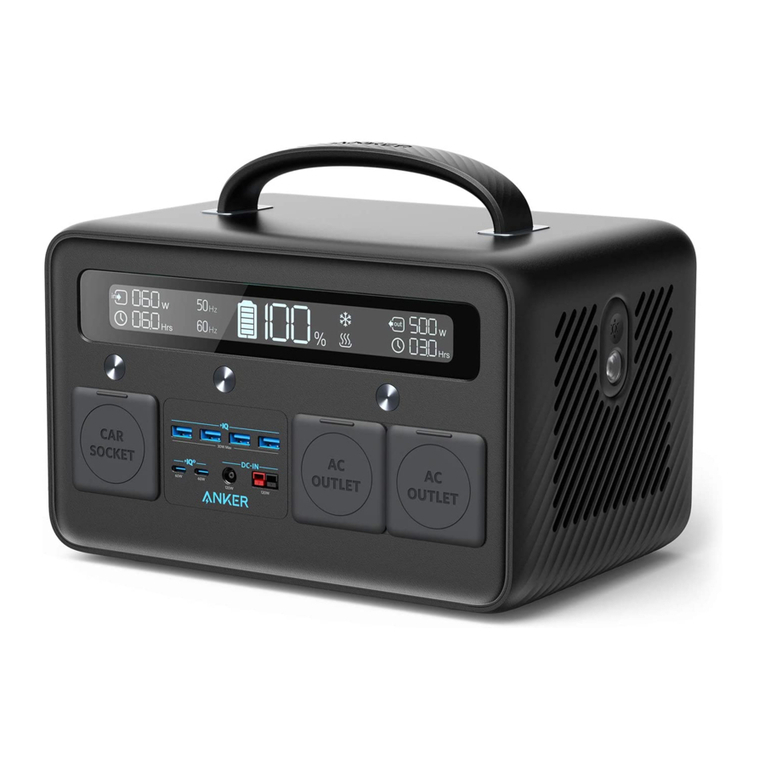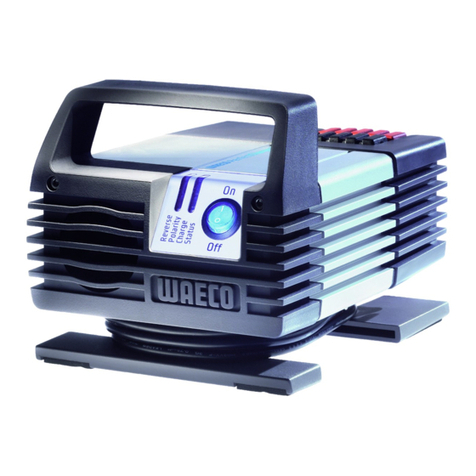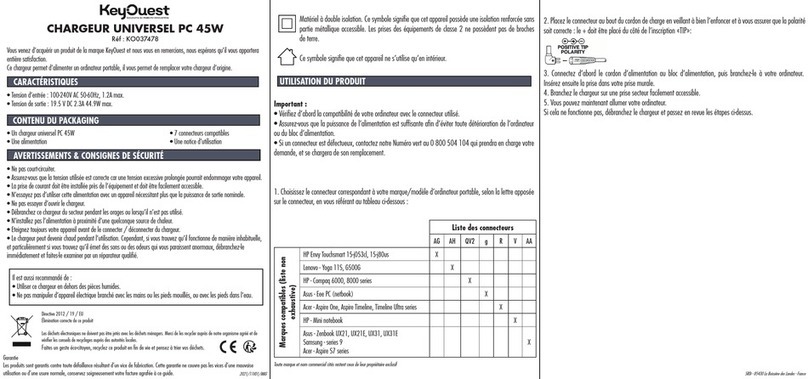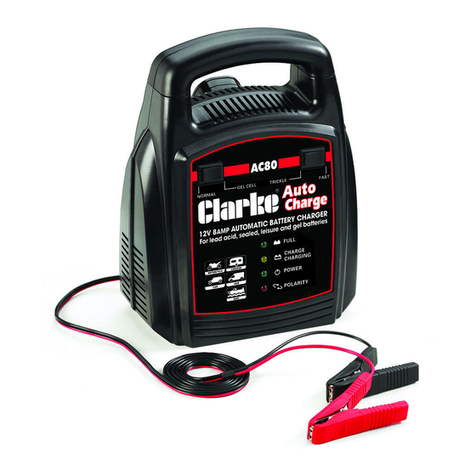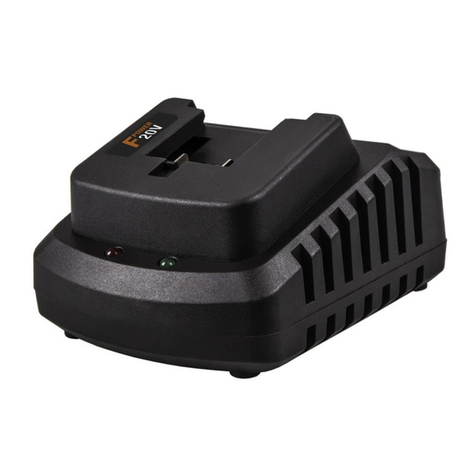autoEXACT AE1000E User manual

READ ENTIRE MANUAL BEFORE USING THIS PRODUCT
Model AE1000E
MULTI-USE SMART BATTERY CHARGER
OWNER’S MANUAL

EN FR DE ES
1LCD monitor Ecran LCD (LCD-Monitor Pantalla LCD
2Mode Button Mode Bouton Modus-Taste Botón de Modo
3Type Button Type de Bouton “Typ”-Taste Botón de Tipo
4AC socket Plug Prise ACWS-Stecker Conector AC
5Clamp set Jeu de pinces Klemmen-Set Set de
abrazaderas
6Ring terminal
set Terminal de
réseau Ringkabelsatz Set de terminal
de anillo.

EN
IMPORTANT SAFETY INSTRUCTIONS:
READ AND SAVE THIS SAFETY ANDINSTRUCTIONMANUAL
1. This manual contains important safety and operating instructions
for this battery charger/maintainer. Please read, understand and
follow these instructions and precautions carefully.
2. Use this charger only on 12 volts, SLI, AGM SPIRAL, AGM
FLATPLATE, GEL, VRLA, CAL/CAL and START-STOP LEAD
ACID battery & LFP batteries. Do not attempt to use on other
voltages and types of batteries (DRY CELL, NICKEL CADMIUM,
NICKEL METAL HYDRIDE, etc.) commonly found in small home
appliances. This may cause chargers and batteries to burst,
resulting in damage or injury to person and property.
3. Do not expose this charger to direct sunlight, rain or snow.
4. If the battery is installed, please make sure that the vehicle is
turned off and no loads are presented.
5. Do not use attachments to this charger that are not recommended
and approved.
Non-recommended attachments may result in injury, electric
shock, or fire and voids the warranty.
6. To reduce risk of damage to electric plug and cord, pull by plug
rather than cord when disconnecting charger.
7. If it is necessary to use an extension cord, it should be properly
grounded cord. Use of improper extension cord could result in a
risk of fire and electric shock.
a) That pins on plug of extension cord are the same number, size,
and shape as those of plug on charger;
b) That extension cord is properly wired and in good electrical
condition;
c) That wire size is large enough for ac ampere rating of charger as
specified in Table.
8. Do not operate charger with damaged cord or plug – replace the
cord or plug immediately.
9. Do not operate charger if it receives a sharp blow, been dropped,
or otherwise damaged in any way; take it to an authorized service
center for repair.
10. Do not disassemble charger; take it to an authorized service center
for repair when service or repair is required. Incorrect reassembly
may result in a risk of electric shock or fire and void the warranty.
11. Don’t replace any components / wires by yourself. If there is
something broken, take it toan authorized service center for repair
when service or repair is required and void the warranty.
12. To prevent injury during cleaning or maintenance, disconnect all
batteries and move them to clear access to the unit. Unplug this
EN. 1

EN
EN. 2
charger from the wall outlet. Use a slightly damp cloth to clean the
housing and lead sets. Do not use solvents or soaps.
13. Place the power cords in a location where will not be stepped on,
tripped over, or subjected to stress or abuse of any kind.
14. Never attempt to charge a frozen battery. Allow the battery to
return to room temperature before connection. Suggested
operation range 0 C (32 F) to 50 C (122 F) in ambient temperature.
15. Never use this charger in or on any boat or watercraft directly. You
must remove the battery from the boat or watercraft and charge the
battery at the properly installed location of this charger.
16. It is not suggested to expose the charger to moisture and should
not be subjected to inclement weather.
17. WARNING – RISK OF EXPLOSIVE GASES
a) WORKING IN VICINITY OF A LEAD-ACID BATTERY IS
DANGEROUS. BATTERIES GENERATE EXPLOSIVE GAS
DURING NORMAL BATTERY OPERATION. FOR THIS
REASON, IT IS OF UTMOST IMPORTANCE THAT YOU
FOLLOW THE INSTRUCTIONS EACH TIME YOU USE THE
CHARGER.
b) To reduce risk of battery explosion, follow these instructions and
those published by battery manufacturer and manufacturer of any
equipment you intend to use in vicinity of battery.
18. RISK OF EXPLOSIVE GASES MIXTURE
a) Connect and disconnect battery leads only when the unit is not
on.
b) For a battery installed in a vehicle, first connect red clamp charger
output lead to the positive “+” battery post and then connect the
black clamp charger output lead to suitable ground away from
battery preferably the chassis; do not connect to carburetor or fuel
lines. Disconnect the black clamp charger output lead first.
c) Do not overcharge battery.
19. PERSONAL PRECAUTIONS
a) Someone should be within range of your voice or close enough to
come to your aid when you work near a lead acid battery.
b) Have plenty of fresh water and soap nearby in case battery acid
contacts skin, clothing or eyes.
c) Wear complete eye protection and protective clothing.
d) Avoid touching eyes while working near battery.
battery. It could spark or short-circuit the battery or other electrical
parts and could cause an explosion.
f) Remove personal metal items such as rings, bracelets, necklaces
and watches when working with a lead acid battery. It can produce
a short circuit current high enough to weld a ring or the like to
metal causing a severe burn.
g) This appliance is not intended for use by persons (including
children) with reduced physical, sensory or mental capabilities, or
lack of experience and knowledge, unless they have been given
supervision or instruction concerning use of the appliance by a
person responsible for their safety.
h) Children should be supervised to ensure that they do not play with
the appliance.

EN
EN. 3
h) Children should be supervised to ensure that they do not play with
the appliance.
i) If battery acid contacts skin or clothing, wash immediately with
soap and water. If acid enters eye, immediately flood eye with
running cold water for at least 10 minutes and get medical attention
immediately.
j) NEVER smoke or allow a spark or flame in vicinity of battery or
engine.
k) Use the AE1000 for charging SLI, AGM SPIRAL, AGM
FLATPLATE, GEL, VRLA, CAL/CAL and START-STOP LEAD
ACID & LFP batteries only. It is not intended to supply power to a
low voltage electrical system other than in a starter-motor
application. Do not use battery charger for charging dry-cell
batteries that are commonly used with home appliances. These
batteries may burst and cause injury to persons and damage to
property.
l) NEVER charge a frozen battery.
20. PREPARING TO CHARGE
RISK OF CONTACT WITH BATTERY ACID. BATTERY ACID IS A
HIGHLY CORROSIVE SULFURIC ACID.
a)Be sure the area around the battery is well ventilated while battery
is being charged. Gas can also be forcefully blown away by the
use of a fan or a non-metallic piece of material.
b)Clean battery terminals. Be careful to keep corrosion from coming
in contact with eyes.
c)Inspect the battery for cracked or broken case or cover. If battery
is damaged, do not use charger.
d)If the battery is not sealed maintenance free, add distilled water in
each cell until battery acid reaches level specified by the
manufacturer This helps purge excessive gas from cells. Do not
overfill. For a battery without cell caps, carefully follow
manufacturer’s recharging instructions.
e)If necessary to remove the battery from vehicle to charge, always
remove ground terminal from battery first. Make sure all
accessories in the vehicle are off to ensure you do not cause any
arcing.
f)Review all battery manufacturers’ specific precautions such as
removing or not removing cell caps while charging and
recommended rates of charge.
g)Determine voltage of battery by referring to car owner’s manual
and make sure it matches output rating of battery charger.
h)If the battery and terminals have a white or bluish material on
them, the charging system performance should be checked. Any
performance issues should be corrected prior to the battery being
replaced after charging.
21. CHARGER/MAINTAINER LOCATION
RISK OF EXPLOSION AND CONTACT WITH BATTERY ACID.
a)Locate charger as far away from battery as DC cables permit.
b)Never place the charger directly above battery being charged.
Gases from battery will corrode and damage charger.

EN
EN. 4
c) Never allow battery acid to drip on charger when reading specific
gravity or filling the battery.
d) Do not operate charger in a closed area with restrict ventilation in
any way.
e) Do not set a battery on top of charger.
22. SETTING UP & OPERATIONS
a) Mount this charger away from any vehicle repair or service. Make
sure never to start or run an engine near the batteries being
charged.
b) Be sure the total amperage used by this charger does not exceed
the amperage capacity of the supply source. If you do not know
how to determine this, have a qualified electrician determine the
capacity for you.
c) Connect and disconnect DC output clips only after setting any
charger switches to the off position and remove AC cord from the
electric outlet. Never allow clips to touch each other.
d) Make sure the battery terminals are clean. Wire brush them if
necessary. Clamp the black end (NEG, -) to the negative battery
terminal. Clamp the red end (POS, +) to the positive battery
terminal.
e)Connect the charger to a grounded power receptacle that is wired
in compliance with local electrical codes.
Note that side mounted batteries will require the insertion of a lead
post adapter. Plain bolts are not good conductors or safe. They will not
allow for an accurate reading and should not be used.
23. AC CONNECTIONS
a) This battery charger is for use on 220-240 Vac. Check your AC
voltage and make sure the version you take is correct.
b) The input lead must be plugged into an outlet that is properly
installed and grounded in accordance with all local codes and
ordinances.
c) The plug pins must fit the receptacles. Do not use with an
ungrounded system.
d) Never alter the AC cord or plug provided. If it does not fit the
outlet, have a properly grounded outlet installed by a qualified
electrician. Improper connection can result in a risk of an electric
shock or electrocution.
24. DC CONNECTION PRECAUTIONS
a) Connect and disconnect DC output clips only after removing AC
cord from the electric outlet. Never allow clips to touch each other.
b) FOR A CHARGER HAVING AN OUTPUT VOLTAGE SELECTOR
SWITCH, REFER TO THECAR OWNER’S MANUAL IN ORDER
TO DETERMINE THE VOLTAGE OF THE BATTERY AND
TO MAKE SURE THE OUTPUT VOLTAGE IS SET AT THE
CORRECT VOLTAGE. IF AN OUTPUT VOLTAGE SELECTOR
SWITCH IS NOT PROVIDED, DO NOT USE THE BATTERY
CHARGER UNLESSTHE BATTERY VOLTAGE MATCHES THE
OUTPUT VOLTAGE RATING OF THE CHARGER.
25. CHARGING WHEN BATTERY IS INSTALLED IN VEHICLE
A SPARK NEAR BATTERY MAY CAUSE BATTERY EXPLOSION
TO REDUCE RISK OF A SPARKNEAR BATTERY:

EN
EN. 5
a) Position the AC and DC cables to reduce the risk of damage by
the hood, door and moving or hot engine parts.
b) NOTE that if it is necessary to close the hood during the charging
process, ensure that the hood does not touch the metal part of the
battery clips or cut the insulation of the cables.
c) Stay clear of fan blades, belts, pulleys and other parts that can
cause injury.
d) Determine which post of the battery is grounded (connected) to
the chassis. If the negative post is grounded to the chassis (as in
most vehicles), see item (e). If the positive post is grounded to the
chassis, see item (f).
e) FOR A NEGATIVE-GROUNDED VEHICLE, connect the
POSITIVE (red) clip from the battery charger to the POSITIVE
(POS, +) ungrounded post of the battery. Connect the NEGATIVE
(black) clip to the vehicle chassis or engine block away from the
battery. Do not connect the clip to the carburetor, fuel lines or
sheet-metal body parts. Connect to a heavy gauge metal part of
the frame or engine block.
f) FOR A POSITIVE-GROUNDED VEHICLE, connect the
NEGATIVE (black) clip from the battery charger to the NEGATIVE
(NEG, -) ungrounded post of the battery. Connect the POSITIVE
(red) clip to the vehicle chassis or engine block away from the
battery. Do not connect the clip to the carburetor, fuel lines or
sheet-metal body parts. Connect to a heavy gauge metal part of
the frame or engine block.
g) Check polarity of battery posts. POSITIVE (POS, P, +) battery
post usually has larger diameter than NEGATIVE (NEG, N, –)post.
h) When disconnecting charger, disconnect AC cord, remove clip
from vehicle chassis, and then remove clip from battery terminal.
26. CHARGING WHEN THE BATTERY IS OUTSIDE VEHICLE
A SPARK NEAR BATTERY MAY CAUSE BATTERY EXPLOSION. TO
REDUCE RISK OF ASPARK NEAR BATTERY:
a) Check polarity of battery posts. POSITIVE (POS, P, +) battery
post usually has a larger diameter than NEGATIVE (NEG, N,
–)post.
b) Connect the POSITIVE (red) charger clip to the POSITIVE (POS,
+) post of the battery and the NEGATIVE (black) charger clip to
the NEGATIVE (NEG, -) post of the battery.
c) Then, connect the AC supply cord to the electrical outlet.
d) POSITION YOURSELF AND THE FREE END OF CABLE AS FAR
AWAY FROM BATTERYAS POSSIBLE, AND THEN CONNECT
THE NEGATIVE (BLACK) CHARGER CLIP TO FREE END OF
CABLE.
e) Do not face battery when making final connection.
f) When disconnecting the charger, always do so in the reverse order
of the connecting procedure and break the first connection while as
far away from the battery as practical.
g) A marine battery must be removed and charged on shore. To
charge it on board requires equipment specially designed for
marine use.

EN
EN. 6
HOW TO CHARGE :
1.At first, connect the charger to the wall socket. The LCD
monitor shows the defaults of battery types/output modes.
2. Press the Mode/Type button to select the charging program.
AE1000E has 3 charging modes and 4 battery types.
(Both can be selected only if the device isn’t connected to the
battery)
3.Connect the clamps (+/-) to the battery for charging
4.The error (Exclamation mark) icon will illuminate or
flash if the battery clamps are incorrectly connected.
Also, the reverse polarity protection will ensure that the
battery or charger will not be damaged.
5.Stop charging at any time by disconnecting AC Plug from
the wall socket.
1.Connect the charger/power supply to the wall socket.
The LCD monitor shows the defaults ofbattery types/
output modes.
2.Press the Mode/Type button to select the Power
supply program. Then it will count down automatically for 5
seconds.
3. Connect AE1000 & Car’s ECU to an active
accessory outlet or clamping directlyto the battery
terminal.
HOW TO REPLACE BATTERY USING THE
POWER SUPPLY FEATURE
4. The error (ER5) icon will illuminate if the battery voltage is too
low. Please refer to the troubleshooting guide to solve the problem.

EN
EN. 7
5. After making sure AE1000 & Car’s ECU is actively
connected, disconnect the battery terminal from the old
battery and remove the old battery. The AE1000 will supply
power to maintain car’s ECU memory during this process.
Note: 1. Please don't let the battery terminal (+) (-) touch
any metal part of the car, or it could disrupt or damage
the circuits in the vehicle. 2. Please don't let the battery
terminal (+) (-) touch together, or it could disrupt or
damage the circuits in the vehicle.
6. Install a new (good) battery. After connecting the new
battery and connecting the battery terminals, you can stop
the power supply function by disconnecting AC Plug from
the wall socket.
Note: 1. Please don't let the battery terminal (+) (-) touch
any metal part of the car, or it could disrupt or damage
the circuits in the vehicle. 2. Please don't let the battery
terminal (+) (-) touch together, or it could disrupt or
damage the circuits in the vehicle.
To select your suitable charging setting, please refer to the following table:
LCD Indicator Application
AGM SPIRAL, AGM FLATPLAT batteries
SLI(Flooded), EFB, CAL/CAL, VRLA and
most of MF batteries
GEL batteries
OPERATION GUIDE
RISK OF DAMAGE!
LFP(LiFePO4) batteries
CAUTION: Please don’t select AGM/STD/
GEL to charge LFP battery. This may
cause batteries to burst, resulting in
damage or injury to person and property.
Small battery mode
Output: 1.5A for 12V batteries
Use for smaller batteries. 2.3Ah to 30Ah
Large battery mode
Output: 10A for 12V batteries
Use for large batteries. 30Ah to 200Ah

EN
EN. 8
RISK OF DAMAGE!
Power supply function: 13.6V – 10A
This function is used to keep vehicle-
computer’s memory active while the battery
is being changed or whenever the battery
is disconnected from the vehicle’s circuit.
CAUTION: IN THIS FUNCTION, THE
BATTERY CHARGER IS NOT PROTECT-
ED AGAINST POLARITYREVERSAL.
Voltage display
The charging voltage will be shown on the
display
Low-temp function
It will start up once the ambient
temperature is lower than 10濎/ 50 ˚F
automatically.
CHARGING INDICATION
Charging-error function
Please refer to the troubleshooting
guide below.
Incorrect battery voltage.
Please refer to the troubleshooting
guide below.
In caseoffaults, the LCD indicator will display the following
indications:
DISPLAY INDICATION PROBLEM SOLUTIONS
Short circuit Check for poor
connectionat
battery or clamps.
Battery
unrecoverable
after a complete
desulfation cycle.
It is a bad battery,
please replace it.
a) Battery capacity
excessive
Use a battery charger with
greater charging capacity.
b) It is a bad
battery which can’t
accept a charge.
It is a bad battery,
please replace it.
TROUBLESHOOTING

EN
EN. 9
Bad power
storage capability
It is a bad battery,
please replace it.
The battery voltage
is too low during
Power supply
mode.
Please check if AE1000
is connected correctly
with a 12V battery
(not a 6V battery).
If you still want to use
the function under
abnormal situation after
checking, please press
and hold the type button
for 3 seconds to activate
the power supply
function MANUALLY.
The Charged LFP
battery is less than
10V
It is a bad battery,
please replace it.
Wrong battery
voltage.
(You are attempting to
charge 24V or more
battery).
The AE1000E is for
12V battery only.
Please use a battery
charger with correct
voltage output.
Connect the clamps
(+/-) to the battery
for charging.
The LCD monitor
just stays in the
Standby mode.
a) Circuit open or
Clamps are not
making a good
connection.
Check for poor
connection at battery
and frame.
b) The battery’s
voltage is lower
than 2V.
Contact your nearest
battery service center
or charge the battery
with a manual charger
to a OCV of 2V or more.
The LCD monitor
can’t be lit
AC end is not
making a good
connection.
Check for poor
connection at AC side.

EN
EN. 10
I
NTELIGENT 9-STAGE CHARGING PROGRAMS
(for 12V Lead-acid battery)
I
NTELIGENT 6-STAGE CHARGING PROGRAMS
(for 12V LiFePO4 battery)
Desulfation: Recovers a deeply discharged or a lightly sulfated
battery.
Soft start: Tests that the battery is in a suitable condition to
receive a charge.
Fast Charge (ready to use): Charges the battery to 75% in the
fastest and most efficient manner.
Repair: If the battery's charged storage capability is week, it will
detect and start the Repair function to recover battery
automatically.
Absorption: When the battery reaches 75% charge, the charger
output is constant with high voltage small current to 90% in a
safe manner.
Pulse: When the battery reaches 90% charge, the charger starts
a charge pulse with a smaller current to fully charge in the safest
manner.
Analysis: Tests that the battery is retaining the charge that has
been delivered.
Top off: Fully charge the battery without overcharging the
battery.
Maintenance:Maintains the battery in a full state of charge.

EN
EN. 11
Charger model AE1000E
Rated voltage AC 220-240VAC, 50-60Hz
Battery type All types of 12V LEAD ACID Batteries,
(AGM, GEL, STD,VRLA, MF, CAL/CAL
and START-STOP) & LFP batteries
Min battery voltage Lead-acid: 2V
LFP: 10V (for safety concerns)
Ambient temp. -20ij to +50ij
Dimensions 210 (L) X 98 (W) X 60 (H) mm
Weight 880 g
Specification
Table of contents
Other autoEXACT Batteries Charger manuals
